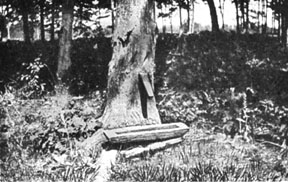The Seasons of the Senecas
© 1995 The Gobbler: Winter Thaw
by Linda Pascatore

Method of tapping trees, Grand River Reserve
The local Seneca Indians here in Western
New York had traditional celebrations for each season. They
lived in close harmony with nature and the flow of the seasons.
They were dependent on the natural environment to provide
them with the basic necessities of their lives; food, clothing
and shelter. Their spirituality was also centered in nature.
They called the earth Mother, the sky Father, the moon Grandmother,
the sun Grandfather, and animals, trees and plants their brothers
and sisters. It was natural for them to celebrate the changing
seasons.
The Senecas were part of the Iroquois Confederacy.
The Iroquois divided the year into four seasons which coincide
with ours. Their new year was probably originally in the Spring,
but after contact with Europeans they began to celebrate it
around the time of the Winter Solstice as we do today. The
names of the seasons, obtained from Chief David Key (Seneca
speaking Onondaga) are;
Winter: gu sa' a gi, "the cold has
arrived"
Spring: diyugwagaho' di, "it is time
to plant or sow"
Summer: gana na' gi, "it red has
come"
(a reference to red strawberries?)
Fall: ganana' ge hagwadi, "the red
colours have come"
The local Native Americans found the twelve
moons of the year more meaningful than our rather arbitrary
system of months, which attempts to fit lunar months into
a solar calendar (see our Gobbler version of a Solar/Moon
calendar). The Iroquois named months after weather conditions
or foods produced at that particular time of year. The names
that follow begin with the first moon after the New Year.
They were provided by John Gibson, historic chief of the Brant
Reservation (near Silver Creek);
disgu' na: "principal mid-winter
moon"
gana du' ha: "leaves falling into
the water from such trees as the oak and beech, to which
they have clung during the winter"
gana du gu' na: "great falling of
leaves under the water now"
he sata: "bushes, shrubs, and plants
begin to grow again"
u hiaigu' na: "berries begin to ripen"
sisge' ha: "plants growing"
sisgegu' na: "almost everything growing
up and bearing something"
gade' a: "food beginning to form"
gade a gu' na: "season when everything
is bearing food"
dijutu' weha: "beginning of cold
weather"
djutuwegu' na: "again it is cold
greatly"
disa: "the sun is returning" (reference
to lengthening days after the Winter Solstice)
The Iroquois celebrated eight major festivals
each year. They often coincided with the seasonal availability
of foods that were staples for area tribes. The dates varied
with local conditions across the Iroquois territory. They
were;
New Year
Tapping the Maple Trees
Maple Sugar Festival
Planting the Corn
Strawberry Festival
Bean Festival
Green Corn Festival
Gathering the Corn.
At this time of year in early spring in the
northeast, the native Americans would have been tapping the
maple trees, as is still done today. Maple syrup is a local
resource and true native food. The Iroquois used bark funnels
as taps and wooden troughs carved from a tree trunk to hold
the sap (see illustration). It was boiled down to make syrup
and used in cooking. At the end of the maple syrup season,
the Maple Sugar Festival was held. The Iroquois festivals
usually included ceremony, singing, dancing, and feasting.
At this particular celebration, the soups were flavored with
the new maple syrup. Making maple sugar seems a natural excuse
for a party at the end of a dreary winter. A modern Maple
Sugar Festival at the Methodist Church in Mayville. We listened
to the children of the parish sing while stirring hot maple
syrup in anticipation of the sweet sugar crystallizing. Maybe
some traditions are so ingrained in time and place that they
cross the lines of culture to become common, shared human
experiences.
Editor's Note: There is little written
on the details of these seasonal events. The Native Americans
used oral traditions; myths, legends and stories. Through
the years, many of these ceremonies were incorporated into
the Long House religion, which is a mixture of traditional
native beliefs and Christianity. Currently, the Long House
ceremonies are not shared with non-native outsiders. If there
are Senecas, Iroquois or other natives in the area who would
like to write something for us or just tell us some stories,
please E mail us. I did find some valuable resources at Barbara
Berry's Book Shop, on Route 394 and Stedman Road, in Stedman,
New York. Warren Berry has an entire series of books which
are reprints of historical writings on many aspects of Iroquois
life. The sources used for this article are Myths of the
Iroquois by E.A. Smith and Iroquois Foods and Food
Preparation by F.W. Waugh; published by Iroqrafts, Ltd.;
Ontario, Canada.
|
